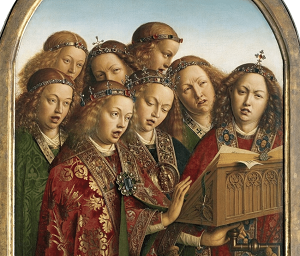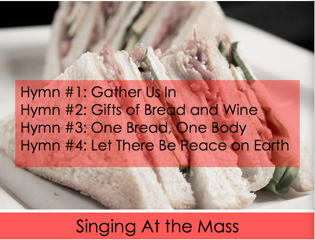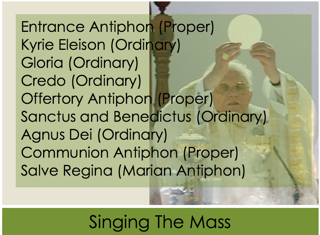

|
| Musical Musings: Liturgy |
|
|
Propers of the Mass versus the Four Hymn SandwichThis article is reprinted from the 15 January 2016 issue of Homiletic & Pastoral Review, with the kind permission of the editor, Fr. David Vincent Meconi SJ. This may be a surprise to most Catholics who attend Masses in the Ordinary Form 1, but we aren't supposed to be singing hymns exclusively or predominantly at Mass. We are supposed to be singing the Mass.
According to authoritative Roman Catholic Church documents on liturgy from before, during, and after the Second Vatican Council, the Church has never stopped wanting us to sing sacred texts that are intrinsically part of each day's Mass. This statement from one Vatican organization in charge of implementing the Vatican II liturgical changes is typical: "[T]exts must be those of the Mass, not others, and singing means singing the Mass not just singing during Mass." 2 I'll never forget an extreme example of how singing during the Mass can be abused, which occurred one Christmas Eve. The Italian choir in which I sang joined with the English and Spanish choirs to provide the music for a multi-lingual 3 Midnight Mass. A musician from the Spanish choir wearing a black leather suit with silver studs and high-heeled black cowboy boots sang John Lennon's "Imagine," accompanying himself on a black and silver electric guitar. "Imagine there's no heaven, it's easy if you try … And no religion too." The Italian choir had just sung their favorite Christmas hymn Tu scendi dalla stelle ("You Descended from the Stars"). What could be more absurd than to follow that pious hymn to the newborn Divino Bambino with an atheist anthem? Actually, what was even more absurd is the fact that no one in the church except for me seemed to think anything was wrong about singing "Imagine" during a Mass. Most sang along. People have gotten used to the absolutely whimsical way music is chosen for Masses, and from this example, it seems that they might not even listen to what the words mean. Mistaken opinions about what we should be singing abound among laity and clergy alike. Only a few weeks before that Christmas Eve, the pastor had told the Italian choir director that the Gloria was not really required during Mass any more, but another song would do, even, for example, "Glory, Glory, Hallelujah!" And, although I love Tu scendi dalla stelle as much as anyone could, even that charming Christmas carol did not belong. The choir should have been singing instead the Scriptural texts that the Church has assigned to the First Mass of Christmas at Night. The topic of what kind of music should be sung at Mass is complex. Experts write about this subject all the time, but they forget to explain many things that are second nature to them in a way that non-experts among the clergy and laity can also understand. I've sung Gregorian chant and sacred polyphony in choirs for about a decade, I have studied with and interviewed several masters of sacred music, and I've done a lot of reading on the topic. So, as a passionate lover of sacred music, I'm going to try to share what I've learned from the experts about what went wrong with Roman Catholic Church music after the Second Vatican Council and what's being done to fix it. Fr. Samuel Weber OSB has a book titled The Proper of the Mass for Sundays and Solemnities: Chants for the Roman Missal in English. His collection is one of many important recent attempts to provide appropriate settings for English Mass texts. In his Foreword, San Francisco Archbishop Salvatore Cordileone wrote that Fr. Weber's work is "invaluable: it provides a resource to enable our people and musicians to sing the biblical texts assigned by the Church to the various moments of the liturgy." You may be asking yourself, "What is the Proper?" Or, maybe, "What's the big deal about a collection of English chant settings?" This article provides definitions of terms, some of the recent history of singing in the Catholic liturgy, and citations from some relevant Church documents that will help you at least get a glimpse of the big picture of what Catholics should be singing at Mass, according to the mind of the Church. What's a Four Hymn Sandwich?Ever since 1969, the vast majority of Masses are celebrated in what is called the Ordinary Form, and a sequence of four hymns is typically sung at the Entrance, the Preparation of the Gifts (Offertory), the Communion, and during the Recessional procession at the end of the Mass. Sacred Music experts often refer to this sequence as the four hymn sandwich, and, while some object to the term as being snarky, I'll use it in this article with no offense intended, because it's colorful and it makes its point.
A lot of Catholics have grown up with the four hymn sandwich, and many have been led to believe (erroneously) that Vatican II abolished Gregorian chant and Latin. Some think that to include chant and Latin to any extent is to take a step back to a dark era, to return to a time when nobody understood what the priest was doing during Mass and when the laity was excluded from participation. This article cannot go off topic far enough to address the false claims that nobody understood Latin and that the laity were excluded from participation during the hundreds of years that the traditional Latin Mass was the only Mass. But it will start by addressing the fact that Vatican II never abolished Gregorian chant and Latin. A good number of priests and church musicians have humbly taken the time to learn what the Church really intends to be sung during the liturgy, but some are afraid it might be safer to leave things the way they are, because the topic of singing at Mass is so fraught with emotion. Many churchgoers are passionately attached to their favorite hymns, and they are not going to stop singing hymns at Mass without a rebellion. There actually have been cases where a pastor's or music director's sincere attempt to gently and slowly re-introduce the minimum of what is spelled out in Church documents about music at Mass has led parishioners to complain so loudly that the pastor or music director has been removed. As many Church music directors and musicians who converse at The Chant Café 4 about their struggles in parishes indicate, it is extremely difficult to change people's minds about what should be sung at Mass. Laying aside the possible resistance, the fact is that when a parish decides what music belongs at Mass, the decision should not be based on what you or I or anyone else may prefer emotionally. Sacred music settings of sacred texts are what the Church teaches are the only fitting music for our worship of our God. And Now a Few Terms: Ordinary? Proper? Poly-Wha?Gregorian chant (otherwise known as plainchant) is the Church's sacred music, which developed as an intrinsic part of the liturgy of the Catholic Church. It is unique among all types of music because it it has always been used only for worship. Some refer to Gregorian chant as 'sung prayer.' Purely melodic, it may be sung by one or several singers, who all sing the same notes. It does not use harmony, counterpoint, or accompaniment 5; even though by definition chant is not accompanied, an organist often accompanies the chants that are supposed to be sung by the congregation to encourage them to sing. Gregorian refers to Pope St. Gregory I, the Great (540-604), who played an important, if disputed, role in codifying which chants are sung during the liturgical year. Unlike modern music, chant is not restricted to two modes, but has many modes, and it does not have a fixed meter or time signature. It has a free rhythm that is uniquely complementary to worship. Polyphony is unaccompanied multi-voiced music that developed from chant. Unlike other forms of music that are often used in Masses these days, chant and polyphony do not carry associations with worldly things in the listeners' minds. For one simple example, music with the instruments and beats of a rock concert are going to stir up the same kinds of emotions evoked at a rock concert. If the words are religious, any song can be said to be religious, but there is a distinction between religious music and sacred music that is important to understand. Religious music is fine, in its place, but only sacred music belongs at Mass. In 1903, Pope Saint Pius X proclaimed that Gregorian chant and sacred polyphony were the official music of the Roman Catholic Church's liturgy. "The musical tradition of the universal Church is a treasure of inestimable value, greater even than that of any other art. The main reason for this pre-eminence is that, as sacred melody united to words, it forms a necessary or integral part of the solemn Liturgy." Subsequent popes, including Pope Paul VI in 1974, have affirmed the same thing. Popes before, during, and after the council also stress the importance of Gregorian chant. Both John Paul II and Benedict XVI also reaffirmed what the Vatican II official constitution on the liturgy stated, that Gregorian chant is the Church's own music, and that it should be "suitably esteemed and employed as the chant proper to the Roman liturgy." The Second Vatican Council devoted a chapter to sacred music in Sacrosanctum Concilium (SC), the constitution on the liturgy. SC was the first of the four Constitutions to be promulgated by the Second Vatican Council (on December 4, 1963), and was voted for by an overwhelming majority of the Fathers of the Council. Paragraph 116 of SC affirmed that Gregorian chant is "specially suited to the Roman liturgy" and that Gregorian chant should have first place among all legitimate types of sacred music. 6 Musicology Professor William P. Mahrt is president of the Church Music Association of America, and his Saint Ann choir continued to sing Latin Gregorian chant in Ordinary Form Masses during the past fifty years — even during the years when it was practically banned. Mahrt has written 7 in Summorum Pontificum, The Musical Shape of the Liturgy and repeated many times elsewhere that the rich repertoire of Gregorian chants in Latin should not be abandoned. Although it might be almost inconceivable that any music written by an individual in our time could approach the state of polished perfection that was achieved by Gregorian chant as it was developed over the ages to be sung for each day of the year, the Church has no objection to new compositions, as long as they are composed according to the supreme model of Gregorian chant. Pope Saint John Paul II repeated in 2003 in his Chirograph for the Centenary of the Motu Proprio Tra Le Sollecitudini: On Sacred Music, the affirmation from SC that Gregorian chant is "specially suited to the Roman Liturgy." Pope John Paul II repeated the words of Pope Pius X that chant is "the supreme model of sacred music," and he continued, "With regard to compositions of liturgical music, I make my own the 'general rule' that Saint Pius X formulated in these words: "The more closely a composition for church approaches in its movement, inspiration and savour the Gregorian melodic form, the more sacred and liturgical it becomes; and the more out of harmony it is with that supreme model, the less worthy it is of the temple." 8 What's in Your Sandwich?Hymns have always had their place in the Divine Office and still belong in the post-councilar Liturgy of the Hours, and in devotions outside of Mass, such as May processions, but the music of the Mass has consisted for hundreds of years of texts from the Scriptures and of other sacred texts set to Gregorian chant and sacred polyphony that developed as part of the Mass. The practice of having the congregation sing four hymns at Mass actually started back in the mid to late 1950s as a way to promote congregational participation during the parts of Low Masses during which the priest was praying silently. Hymn singing came into Catholic Masses by way of Protestant worship services, some say from Methodism. The movement to allow hymn singing at Masses came from Germany and the low countries. Martin Luther is the one who first propagated the communal singing of hymns in the German language in worship service in the 16th century. Before Luther, many hymns existed but they weren't sung in Masses. One of Luther's biggest goals was to "restore worship to the people," so Luther set to work and wrote thirty-seven hymns in German for the people to sing during his new Sunday worship service. Luther started such an explosion of hymn writing that by the time he died, sixty German hymnals had been published, and the explosion continued so that a remarkable twenty-five thousand German hymnals had been published by sixty years after his death. Although Luther removed many parts of the Mass that did not fit his theological formulations, he was conservative compared to the later founders of other denominations. Protestant reformers continued removing more and more parts of the Mass that they didn't agree with, until what was left in most denominations was a stripped down service consisting of congregational hymn singing, didactic prayers, readings from scriptures, and long sermons, with a communion service once a month or once a year. A worship service without the Eucharistic sacrifice and the singing of the prayers of the Mass needs lots of hymns and a long, long sermon. Before the Second Vatican Council, during the period when hymns were allowed for Catholics to sing at low Mass, hymns did not replace the prescribed Mass texts, but were an addition to them. But after Vatican II, unfortunately, hymns were treated as a replacement for the prescribed texts. This happened because when the Mass of 1969 in the local languages was introduced, the distinction between Low and High Mass was removed, and the practice of singing hymns spread into all Masses irrespective of the Mass' solemnity. The singing of the prescribed Mass texts (which still existed) almost totally disappeared as a result of the haste in which the new form of the Mass was implemented. In the new form of the Mass, the texts of the Mass that had been in Latin were now in the vernacular, but there was no music available to go with the vernacular translations for years. The magisterial documents directed that people should sing, but there was a big hole because ther was no music provided for the translated texts. Hymns moved into the void. One big problem with the current situation is that the hymns are often selected from 20 to 30 old favorites that are sung week after week, and they do not usually have any discernable connection to that particular day's place in the liturgical year. Another big problem is that hymns seldom seem connected, as they ought to be, to the sacred actions going on in the parts of the Mass during which they are sung. The hymns seem to be picked at the random whim of whoever gets to select the songs that day; and as my earlier example shows, they sometimes are actually heretical. There is a movement to return to singing the parts of the Mass that have been ignored, and Fr. Weber's collection of chant settings of approved English texts is a valuable contribution to that movement. Archbishop Cordileone wrote in his Foreword to Fr. Weber's The Proper of the Mass for Sundays and Solemnities about how the collection fills the void that the hymns moved into. "Now, thanks to the efforts of Father Weber, a recognized expert in the field of chant, it is possible for us to sing the entire Eucharistic liturgy." What's 'Ordinary' Mean in Church Speak?The parts of a Mass that do not change every week are called the Ordinary. The following table lists the Ordinary parts of the Mass.
Great composers through the ages have written many musical settings for the Ordinary parts of the Mass, and the collection of the five standard parts is called a Mass. For example, the Mass for Three Voices by William Byrd (composed in the 1590s) has the same five parts of the Ordinary as Missa Papæ Francisci ("Mass of Pope Francis") by Ennio Morricone, which premiered in 2015. Who Sings the Ordinary?
We Do!
|
Submit Your Music / Contact Us / Company Description / Links
 In case the term Ordinary Form is not a familar one to some of you, here is a bit of explanation.
Pope Benedict XVI first introduced the terms Ordinary Form and Extraordinary Form in his 2007 document on the liturgy,
In case the term Ordinary Form is not a familar one to some of you, here is a bit of explanation.
Pope Benedict XVI first introduced the terms Ordinary Form and Extraordinary Form in his 2007 document on the liturgy, 


